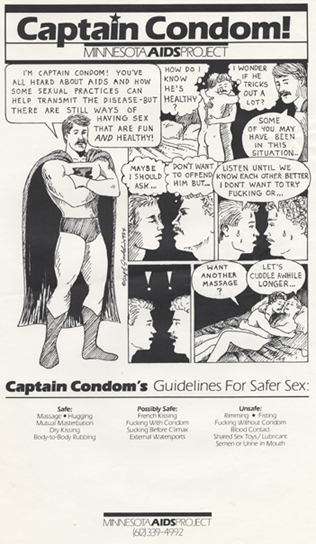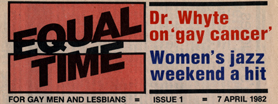Minnesota AIDS Project (MAP)
| Many Minnesotans initially felt far-removed from the curious “Gay Cancer” in Los Angeles and New York City, which received a modicum of newspaper attention in 1981. At the time, medical professionals attributed this ailment to 41 men in New York and California. In just one year, the outbreak of HIV/AIDS (then referred to as the Gay-Related Immunodeficiency Disease or GRID) was occurring at a rate of 5 new cases a week.(1)
The Minnesota AIDS Project (MAP) formed when the Center for Disease Control confirmed two Acquired Immunodeficiency Syndrome-related deaths in the Twin Cities. At the urging of future Councilman Brian Coyle (see: Old Minneapolis Courthouse/City Hall), the mayors of Minneapolis and St. Paul organized a coalition of community members, government officials, and community representatives in July of 1983.(3) |
An example of the Minnesota AIDS Projects comic, "Captain Condom," who advocated a strict form of safe sex.Courtesy of the Jean-Nickolaus Tretter Collection.
|
| Equal Time Issue 1: Front Page. John Whyte became the founder of MAP one year later. Courtesy of the Jean-Nickolaus Tretter Collection. |
The young organization initially focused on financially supporting AIDS victims who fell through the unequipped health care system—the months progressed and AIDS-related deaths increased exponentially. |
MAP began to include safe-sex education campaigns within a year of its founding. Upon learning that HIV/AIDS was transferred through body fluid exchanges, the AIDS Project unsuccessfully advocated alternative forms of sexual activity—including massages, cuddling, and kissing. A condom advocacy campaign replaced the former by 1990, and MAP’s efforts targeted other affected groups—namely, people of color, blood recipients, and intravenous needle users.
Community attention to the AIDS pandemic diminished throughout the late 1990s and 2000s. MAP’s work remains life-saving and essential—as of 2010, the infection rate for Minnesotans is at the same level it was in 1993.(4) To date, almost 3,000 Minnesotans have died from the disease.(5)
This entry is part of:
Minneapolis/St. Paul, MN: 100 Queer Places in Minnesota History, (1860-2010)
(1)Whyte, John. "New Lethal Cancer linked to Gay Community." Equal Time News, Issue 1: 4/7/1982. Page 11.
(2)Ibid.
(3)Stults, Eric. "Mayors: Task Force Organized" Equal Time News, issue 33: 7/13/1983. Page 1.
(4)Marcotty, Josephine. "HIV Strikes the Next Generation" The Minneapolis Star- Tribune: 3/16/10. http://www.startribune.com/lifestyle/health/82694812.html
(5)Remmick, Russel. "3 Decades and 2,976 Minnesota Deaths Later." Lavender Magazine, Issue 366. http://www.lavendermagazine.com/archives/issue-366/3-decades-and-2976-minnesota-deaths-later/

